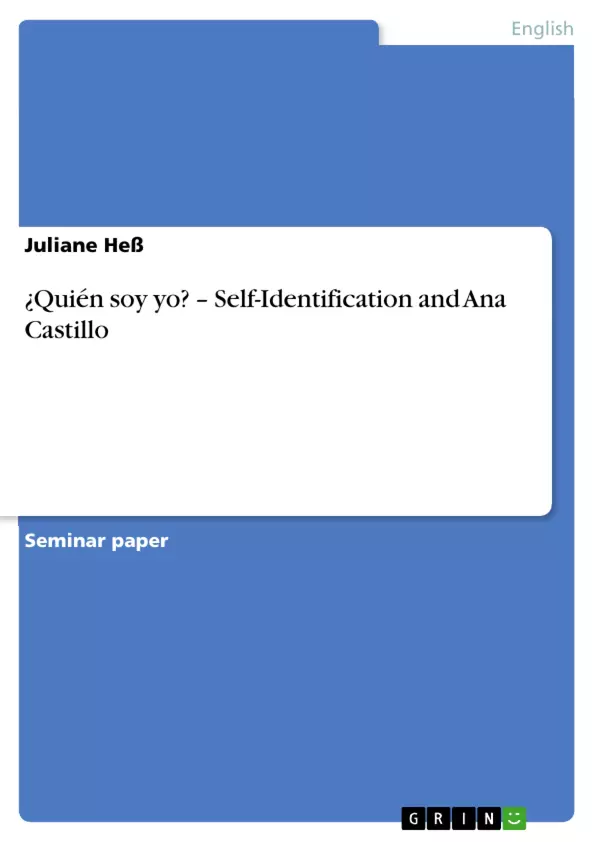¿Quién soy yo? or Who am I? One question is expressed in two languages. But there are numerous answers one can give. Some would say their gender and define themselves as being a man or a woman. Others would simply give their names or their religions. One could also reveal the nationality, the origin or the own social strata. There are a lot of possible answers to this question as humans perceive and identify themselves differently. But people cannot say who they are by using just one single criterion. “Of course, all of us have multiple identities. We may identify ourselves simultaneously as, for instance, woman, socialist, ecological farmer, world citizen, mother, daughter, wife, researcher, Finnish, Scandinavian, European, witch, theosopher, lover of music and plants, and so on (Fishman 54).”
Having a closer look at the meaning of the word “identity” the Oxford English Dictionary gives a proper definition of the word: “identities are the characteristics, feelings or beliefs that distinguish people from others.” This definition shows that identities are not just formed by the own person. It must rather be seen in relation to other humans. The system of society prescribes certain role models humans are expected to fulfil be it on grounds of their sex, race or their economic class. This is also what the personal identity shapes. What if someone does not really know who he or she? Of course, there are some basic answers one can give like the gender or the name but in some cases it is quite hard for people to be aware of themselves. Some marginal groups do not have that feeling of belonging to either side, for example black or white. They are brown, or simply an “in-between case”. They are a mixture of both colours and still in the process of defining themselves or simply lost in it...
Inhaltsverzeichnis (Table of Contents)
- Introduction
- Who are Chicanas?
- Who is Ana Castillo?
- The Mixquiahuala Letters
- A Feminist Identity
- The Journey against the Order
- No Country to call a Home
- Language as a Means of Self-Identification
- Women do not riot
- What is Love?
- Conclusion
- List of Sources
Zielsetzung und Themenschwerpunkte (Objectives and Key Themes)
This paper explores the complexities of self-identification, particularly within the context of Chicana culture and literature. Through the lens of Ana Castillo's work, the analysis examines the challenges faced by Chicanas in navigating cultural expectations, societal pressures, and their own personal identities.
- The struggle for self-definition within the context of Chicana identity
- The interplay of gender, race, and cultural belonging in shaping Chicana experiences
- The use of language and literature as tools for Chicanas to express their voices and challenge dominant narratives
- The role of sexuality and feminist consciousness in Chicana identity formation
- The influence of historical figures and cultural narratives on Chicana self-perception
Zusammenfassung der Kapitel (Chapter Summaries)
The introduction delves into the concept of identity, exploring the multiplicity of factors that contribute to self-perception. It emphasizes the challenges faced by marginalized groups, particularly Chicanas, in finding their place within a society that often seeks to define them.
Chapter two examines the multifaceted and often contradictory understandings of the Chicana identity. It highlights the historical and social factors that have shaped Chicana experiences, including societal expectations, cultural pressures, and the struggle for recognition and agency. The chapter also explores the complexities of navigating between two cultures and the challenges of maintaining ethnic identity while navigating US society.
Chapter three introduces Ana Castillo as a contemporary Chicana writer whose works reflect the experiences and challenges faced by Chicanas. The chapter provides an overview of Castillo's work, focusing on her engagement with themes of identity, cultural belonging, and feminist consciousness.
Chapter four focuses on Ana Castillo's novel "The Mixquiahuala Letters." It analyzes how the characters in the novel grapple with issues of identity, cultural belonging, and relationships within a context marked by societal and cultural pressures. This chapter examines key themes, including feminist identity, the search for cultural roots, the challenges of finding a place in a society where one is often considered an outsider, and the use of language as a means of self-expression.
Schlüsselwörter (Keywords)
This paper focuses on Chicana identity, feminist consciousness, cultural belonging, language as a tool for self-expression, sexuality, and the role of historical figures and cultural narratives in shaping Chicana self-perception. Key terms include: Chicana, Chicana literature, Ana Castillo, The Mixquiahuala Letters, feminist identity, cultural appropriation, language, sexuality, tres madres, and La Malinche.
- Citar trabajo
- Juliane Heß (Autor), 2009, ¿Quién soy yo? – Self-Identification and Ana Castillo, Múnich, GRIN Verlag, https://www.grin.com/document/177589



